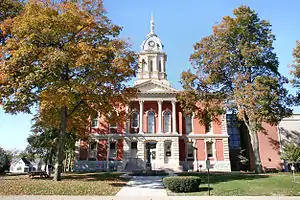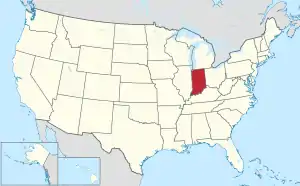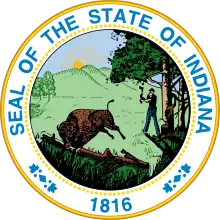Marshall County, Indiana
Marshall County is a county in the U.S. state of Indiana. Census 2020 recorded the population at 67,051.[1] The county seat (and only city) is Plymouth.[2]
Marshall County | |
|---|---|
 Marshall County courthouse in Plymouth, Indiana | |
 Location within the U.S. state of Indiana | |
 Indiana's location within the U.S. | |
| Coordinates: 41°20′N 86°16′W | |
| Country | |
| State | |
| Founded | 7 February 1835 (authorized) 1836 (organized) |
| Named for | John Marshall |
| Seat | Plymouth |
| Largest city | Plymouth |
| Area | |
| • Total | 449.74 sq mi (1,164.8 km2) |
| • Land | 443.63 sq mi (1,149.0 km2) |
| • Water | 6.11 sq mi (15.8 km2) 1.36%% |
| Population | |
| • Estimate (2018) | 46,248 |
| • Density | 104.2/sq mi (40.2/km2) |
| Time zone | UTC−5 (Eastern) |
| • Summer (DST) | UTC−4 (EDT) |
| Congressional district | 2nd |
| Website | www |
| Indiana county number 50 | |
History
The Indiana State Legislature passed an omnibus county bill[3] on 7 February 1835 that authorized the creation of thirteen counties in northeast Indiana, including Marshall.[4] It was named for U.S. Chief Justice John Marshall, who died in 1835.[5] The government of the county was organized in 1836, during the early years of settlement and before the forced removal of the Potawatomi people in 1838. The first settlers had arrived in the county in 1835; they arrived as a result of the end of the Black Hawk War as well as the completion of the Erie Canal. They consisted primarily of settlers from New England, "Yankees" descended from the English Puritans who settled New England in the colonial era. They were mainly members of the Congregational Church, although due to the Second Great Awakening many of them had converted to Methodism and some had become Baptists before migrating to the new area. As a result of this heritage, some place names in Marshall County are named after places in New England, such as Plymouth, which is named after Plymouth, Massachusetts, the site where the Mayflower landed in 1620.[6]
Geography
The low, rolling hills of Marshall County are completely devoted to agriculture where possible (significant drainages are wooded).[7] The highest points on the terrain are three approximately equal swells (900'/274 meters ASL) along the south border line with Fulton County, 1.4 mile (2.2 km) NW of Richland Center.[8]
Marshall County contains three significant bodies of water: Lake of the Woods (NE portion); Lake Maxinkuckee (SW portion); and part of Koontz Lake (NW portion).[7] The Yellow River flows through northern, central, and western portions of Marshall County, past Plymouth; the Tippecanoe River flows southwesterly through the SE part of the county.[9]
According to the 2010 census, Marshall County has a total area of 449.74 square miles (1,164.8 km2), of which 443.63 square miles (1,149.0 km2) (or 98.64%) is land and 6.11 square miles (15.8 km2) (or 1.36%) is water.[10]
Adjacent counties
- St. Joseph County - north
- Elkhart County - northeast
- Kosciusko County - east
- Fulton County - south
- Pulaski County - southwest
- Starke County - west/CST Border
Protected areas
- Menominee Wetland Conservation Area (W of Plymouth)
- Potawatomi Wildlife Park (on W bank of Tippecanoe River in SE county)
Communities
Census-designated place
- Koontz Lake (partial)
Unincorporated communities
- Burr Oak
- Donaldson
- Harris
- Hibbard
- Inwood (called "Pearson" 1854-1856)
- Maxinkuckee
- Old Tip Town
- Teegarden
- Tippecanoe
- Tyner
- Walnut
Climate and weather
| Plymouth, Indiana | ||||||||||||||||||||||||||||||||||||||||||||||||||||||||||||
|---|---|---|---|---|---|---|---|---|---|---|---|---|---|---|---|---|---|---|---|---|---|---|---|---|---|---|---|---|---|---|---|---|---|---|---|---|---|---|---|---|---|---|---|---|---|---|---|---|---|---|---|---|---|---|---|---|---|---|---|---|
| Climate chart (explanation) | ||||||||||||||||||||||||||||||||||||||||||||||||||||||||||||
| ||||||||||||||||||||||||||||||||||||||||||||||||||||||||||||
| ||||||||||||||||||||||||||||||||||||||||||||||||||||||||||||
In recent years, average temperatures in Plymouth have ranged from a low of 16 °F (−9 °C) in January to a high of 86 °F (30 °C) in July, although a record low of −25 °F (−32 °C) was recorded in January 1985 and a record high of 109 °F (43 °C) was recorded in July 1936. Average monthly precipitation ranged from 1.86 inches (47 mm) in February to 4.48 inches (114 mm) in June.[11]
Government
The county government is a constitutional body, and is granted specific powers by the Constitution of Indiana, and by the Indiana Code.
County council: The legislative branch of the county government; controls spending and revenue collection in the county. Representatives are elected to four-year terms from county districts. They set salaries, the annual budget, and special spending. The council has limited authority to impose local taxes, in the form of an income and property tax that is subject to state level approval, excise taxes, and service taxes.[12][13]
Board of commissioners: The executive body of the county; commissioners are elected county-wide, to staggered four-year terms. One commissioner serves as president. The commissioners execute acts legislated by the council, collect revenue, and manage the functions of the county government.[12][13]
Current commissioners: Stan Klotz, Mike Burroughs, Kevin Overmyer (as of July 2020)
Court: The county maintains a small claims court that handles civil cases. The judge on the court is elected to a term of four years and must be a member of the Indiana Bar Association. The judge is assisted by a constable who is also elected to a four-year term. In some cases, court decisions can be appealed to the state level circuit court.[13]
County Officials: The county has other elected offices, including sheriff, coroner, auditor, treasurer, recorder, surveyor, and circuit court clerk. Officials are elected to four-year terms. Members elected to county government positions are required to declare party affiliations and to be residents of the county.[13]
Marshall County is part of Indiana's 2nd congressional district and is currently represented by Jackie Walorski in the United States Congress.[14] It is also part of Indiana Senate districts 5 and 9[15] and Indiana House of Representatives districts 17 and 23.[16]
| Year | Republican | Democratic | Third parties |
|---|---|---|---|
| 2016 | 67.4% 12,288 | 26.3% 4,798 | 6.3% 1,155 |
| 2012 | 63.3% 11,260 | 34.5% 6,137 | 2.3% 404 |
| 2008 | 56.0% 10,406 | 42.5% 7,889 | 1.5% 276 |
| 2004 | 67.8% 12,074 | 31.4% 5,593 | 0.8% 147 |
| 2000 | 63.6% 10,266 | 34.3% 5,541 | 2.1% 343 |
| 1996 | 52.8% 8,158 | 35.5% 5,486 | 11.6% 1,796 |
| 1992 | 48.6% 8,048 | 29.7% 4,912 | 21.8% 3,607 |
| 1988 | 65.4% 10,490 | 34.2% 5,488 | 0.4% 60 |
| 1984 | 68.8% 11,100 | 30.5% 4,931 | 0.7% 113 |
| 1980 | 62.2% 10,209 | 31.2% 5,113 | 6.6% 1,089 |
| 1976 | 59.2% 9,707 | 39.2% 6,424 | 1.7% 277 |
| 1972 | 73.0% 11,908 | 26.7% 4,349 | 0.3% 51 |
| 1968 | 56.7% 9,290 | 32.9% 5,385 | 10.5% 1,719 |
| 1964 | 48.1% 7,895 | 51.2% 8,397 | 0.8% 123 |
| 1960 | 62.5% 10,460 | 37.1% 6,210 | 0.4% 74 |
| 1956 | 65.7% 10,504 | 33.8% 5,398 | 0.5% 80 |
| 1952 | 63.1% 9,990 | 35.0% 5,538 | 1.9% 300 |
| 1948 | 57.0% 7,873 | 41.0% 5,661 | 2.1% 285 |
| 1944 | 59.9% 8,225 | 38.3% 5,254 | 1.9% 257 |
| 1940 | 56.4% 7,718 | 42.8% 5,852 | 0.8% 111 |
| 1936 | 47.2% 6,118 | 51.3% 6,651 | 1.6% 202 |
| 1932 | 39.8% 4,943 | 58.1% 7,212 | 2.0% 252 |
| 1928 | 60.2% 6,738 | 39.1% 4,377 | 0.6% 70 |
| 1924 | 53.2% 5,354 | 42.5% 4,277 | 4.3% 429 |
| 1920 | 53.6% 5,708 | 43.5% 4,631 | 2.9% 303 |
| 1916 | 44.6% 2,855 | 50.4% 3,221 | 5.0% 320 |
| 1912 | 20.2% 1,196 | 48.3% 2,859 | 31.5% 1,863 |
| 1908 | 45.3% 2,947 | 50.5% 3,287 | 4.2% 270 |
| 1904 | 48.4% 3,001 | 46.4% 2,878 | 5.2% 323 |
| 1900 | 45.1% 2,947 | 52.8% 3,449 | 2.1% 135 |
| 1896 | 44.5% 2,938 | 54.3% 3,588 | 1.3% 83 |
| 1892 | 43.4% 2,558 | 52.8% 3,113 | 3.8% 222 |
| 1888 | 43.7% 2,582 | 54.0% 3,188 | 2.3% 138 |
Demographics
| Historical population | |||
|---|---|---|---|
| Census | Pop. | %± | |
| 1840 | 1,651 | — | |
| 1850 | 5,348 | 223.9% | |
| 1860 | 12,722 | 137.9% | |
| 1870 | 20,211 | 58.9% | |
| 1880 | 23,414 | 15.8% | |
| 1890 | 23,818 | 1.7% | |
| 1900 | 25,119 | 5.5% | |
| 1910 | 24,175 | −3.8% | |
| 1920 | 23,744 | −1.8% | |
| 1930 | 25,077 | 5.6% | |
| 1940 | 25,935 | 3.4% | |
| 1950 | 29,468 | 13.6% | |
| 1960 | 32,443 | 10.1% | |
| 1970 | 34,986 | 7.8% | |
| 1980 | 39,155 | 11.9% | |
| 1990 | 42,182 | 7.7% | |
| 2000 | 45,128 | 7.0% | |
| 2010 | 47,051 | 4.3% | |
| 2018 (est.) | 46,248 | [18] | −1.7% |
| US Decennial Census[19] 1790-1960[20] 1900-1990[21] 1990-2000[22] 2010-2013[1] | |||
As of the 2010 United States Census, there were 47,051 people, 17,406 households, and 12,516 families in the county.[23] The population density was 106.1 inhabitants per square mile (41.0/km2). There were 19,845 housing units at an average density of 44.7 per square mile (17.3/km2).[10] The racial makeup of the county was 93.5% white, 0.5% black or African American, 0.5% Asian, 0.2% American Indian, 3.8% from other races, and 1.5% from two or more races. Those of Hispanic or Latino origin made up 8.4% of the population.[23] In terms of ancestry, 35.4% were German, 11.2% were Irish, 9.4% were American, and 8.5% were English.[24]
Of the 17,406 households, 35.2% had children under the age of 18 living with them, 57.2% were married couples living together, 9.9% had a female householder with no husband present, 28.1% were non-families, and 24.1% of all households were made up of individuals. The average household size was 2.66 and the average family size was 3.15. The median age was 38.4 years.[23]
The median income for a household in the county was $47,697 and the median income for a family was $58,017. Males had a median income of $43,732 versus $30,033 for females. The per capita income for the county was $22,493. About 8.7% of families and 12.2% of the population were below the poverty line, including 17.1% of those under age 18 and 10.4% of those age 65 or over.[25]
References
- "Marshall County QuickFacts". US Census Bureau. Archived from the original on June 7, 2011. Retrieved September 25, 2011.
- "Find a County". National Association of Counties. Retrieved June 7, 2011.
- John W Tyndall & OE Lesh, Standard history of Adams and Wells Counties, Indiana. pp. 284-6 (accessed 9 August 2020)
- The counties are Dekalb, Fulton, Jasper, Jay, Kosciusko, Marshall, Newton, Porter, Pulaski, Stark, Steuben, Wells, and Whitley. Newton County was merged with Jasper County in 1839, and was re-authorized as a separate county in 1859.
- De Witt Clinton Goodrich & Charles Richard Tuttle (1875). An Illustrated History of the State of Indiana. Indiana: R. S. Peale & co. pp. 567.
- McDonald, Daniel. A Twentieth Century History of Marshall County, Indiana (Vol. 1)
- Marshall County IN (Google Maps, accessed 29 July 2020)
- Marshall County High Point, Indiana (PeakBagger.com, accessed 29 July 2020)
- Indiana Atlas & Gazetteer. Yarmouth ME: DeLorme. 1998. pp. 20–21, 26–27. ISBN 0-89933-211-0.
- "Population, Housing Units, Area, and Density: 2010 - County". US Census Bureau. Archived from the original on February 12, 2020. Retrieved July 10, 2015.
- "Monthly Averages for Plymouth IN". The Weather Channel. Retrieved January 27, 2011.
- Indiana Code. "Title 36, Article 2, Section 3". IN.gov. Retrieved September 16, 2008.
- Indiana Code. "Title 2, Article 10, Section 2" (PDF). IN.gov. Retrieved September 16, 2008.
- "US Congresswoman Jackie Walorski". US Congress. Archived from the original on May 16, 2008. Retrieved August 5, 2019.
- "Indiana Senate Districts". State of Indiana. Retrieved July 14, 2011.
- "Indiana House Districts". State of Indiana. Retrieved July 14, 2011.
- Leip, David. "Atlas of US Presidential Elections". uselectionatlas.org. Retrieved May 18, 2018.
- "Population and Housing Unit Estimates". Retrieved July 26, 2019.
- "US Decennial Census". US Census Bureau. Retrieved July 10, 2014.
- "Historical Census Browser". University of Virginia Library. Retrieved July 10, 2014.
- "Population of Counties by Decennial Census: 1900 to 1990". US Census Bureau. Retrieved July 10, 2014.
- "Census 2000 PHC-T-4. Ranking Tables for Counties: 1990 and 2000" (PDF). US Census Bureau. Retrieved July 10, 2014.
- "Profile of General Population and Housing Characteristics: 2010 Demographic Profile Data". US Census Bureau. Archived from the original on February 13, 2020. Retrieved July 10, 2015.
- "Selected Social Characteristics in the US – 2006-2010 American Community Survey 5-Year Estimates". US Census Bureau. Archived from the original on February 14, 2020. Retrieved July 10, 2015.
- "Selected Economic Characteristics – 2006-2010 American Community Survey 5-Year Estimates". US Census Bureau. Archived from the original on February 14, 2020. Retrieved July 10, 2015.
